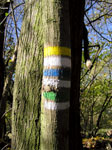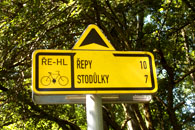| |
About the Prague-Vienna Greenways
What is the Prague-Vienna Greenways System?
 Rather than just a single path, the Prague-Vienna Greenways is really a 250-350
mile long web of trails and country roads that offers variation and diversity to the traveler.
Thanks to support from the Greenways-Zelene stezky, the main PVGW route now includes additional
loop-greenways that were created by local groups and members of the PVGW Association Rather than just a single path, the Prague-Vienna Greenways is really a 250-350
mile long web of trails and country roads that offers variation and diversity to the traveler.
Thanks to support from the Greenways-Zelene stezky, the main PVGW route now includes additional
loop-greenways that were created by local groups and members of the PVGW Association
Selected Projects of the PVGW Association (PDF)
Greenways are routes, trails or natural corridors used in harmony with their ecological function.
They foster the preservation of natural and cultural heritage, provide options for safe transportation,
recreation and tourism, and encourage a healthier lifestyle. Greenways bring local people and businesses
together with regional and state governments to work towards improvement of their communities.
What Do You Want to See?
Prague-Vienna Greenways let you take a journey along centuries-old salt, silver and amber trade routes,
allowing you to discover the most interesting, off-the-beaten path places, closed off for forty years
behind the Iron Curtain. You visit castles and historic villages and admire the architectural monuments,
some declared World Heritage Sites by UNESCO. Walk or bike through fragrant meadows, watch rare birds
fly over peaceful fields. Taste fine Moravian wines and varieties of hearty Czech beer and attend concerts
and festivals of high quality and fun. And...meet local people!

 You walk on the well-marked hiking trails that meander in and out of towns and villages, or bike on the newly marked Greenways biking route on small country roads. You may also canoe down the beautiful Vltava or Sazava
Rivers, or enjoy a horseback ride on the Lednice castle estate, or around peaceful lakes in Trebon. You walk on the well-marked hiking trails that meander in and out of towns and villages, or bike on the newly marked Greenways biking route on small country roads. You may also canoe down the beautiful Vltava or Sazava
Rivers, or enjoy a horseback ride on the Lednice castle estate, or around peaceful lakes in Trebon.
- Lower Vltava River Valley Greenway
Prague
...Sedlec-Prcice
...Bechyne
...Tabor
In the valley of the Vltava River and its tributaries, amid deep canyons,
rolling hills, and well-tended farms, one will discover unspoiled towns and
villages. Historic castles and churches that sheltered pilgrims
during the Middle ages, dot the countryside, contrasting with the modest
folk-architecture of the towns and farms.
- Upper Vltava River Valley Greenway
Hluboka
...Ceske Budejovice
...Cesky Krumlov
Nestled in the gentle foothills of the Sumava Mountains, this section of the
Greenway follows the lively Vltava River as it begins its long course to Prague.
In the deep Vltava valley, ancient farms, alternate with well managed forests such as Blansky les, an unspoiled
forest preserve guarded by 2000 year old Celtic and Slavic fortifications on the
surrounding hilltops. Dramatic rock formations glint with multicolored garnet crystals.
Astride ancient trade routes between Europe and Orient, South Bohemia in the
Middle Ages was a lively marketplace for commodities, especially salt and
amber, and culture. In wealth and power, the local landlords and merchant
princes — the Rozmberks and Schwarzenberg families, and others — came to rival
their kings, gracing the landscape with enough Gothic and Baroque churches,
and enough castles and chateaux to satisfy your most romantic dreams.
The fortified strongholds of Cesky Krumlov, Ceske Budejovice and Hluboka
became the cosmopolitan centers of culture, commerce, and security for vast
baronial and royal estates of the region.
- Bohemia Lake District Greenway
Jindrichuv Hradec
...Trebon
This section of the greenway is a vast idyllic park in which meadows and
solitary oaks are mixed with deep woods, fields and sweeping lakes. The region
began to flourish around the fortified towns of Trebon and Jindrichuv Hradec
in the 13th century. The towns reached their peak as centers of culture and
commerce in the 16th century under the wealthy Rozmberk family, who, it is
said, could ride from Prague to Linz without leaving their property.
The beauty of the countryside was shaped over centuries by the draining of
the marshlands and lakes. In the 16th century the many streams from the
Novohradske Mountains to the south were dammed, creating a network of rybnik
lakes, some of them as large as 10 miles in circumference. As a result, an
important fishing industry grew up to support the area, supplemented by
agriculture and the brewing of the fine local Regent beer. To the south of
Trebon, in the mountainous enclaves along the Austrian border lie towns
such as Nove Hrady, which were restricted to all but few people during the
former regime.
- Towns of the Rennaissance Greenway
Slavonice
...Dacice
...Telc
This section of the Greenway was among the last of the Czech lands to be
settled. The area grew up around the towns of Telc Slavonice and Dacice,
fortified towns that developed in the 10th-12th centuries along the trade
routes, and sheltered caravans carrying salt, amber, silver and gold.
The tolls they charged made the town merchants rich, and the towns flourished
with the construction of fairy-tale houses and noble public squares. Telc
and Slavonice are considered two of the most beautiful Renaissance towns
anywhere in Europe.
- Dyje River Valley Greenway
Vranov nad Dyji...Znojmo
For thousands years it was a natural border, guarded by medieval castles. This
area of Southern Moravia is also a wine country. Wine cultivation probably
reached here in the first century AD with the arrival of the Roman legions
who made camp on the banks of the Dyje River. Wine was certainly grown from
the time of the first Slavonic states supplying the early Czech kings with
wines. The castles and towns of Vranov nad Dyji and Znojmo and Bitov are the
main attraction in this section.
- Palava Hills Greenway
Mikulov
...Lednice
...Valtice
The rolling landscape, reminiscent of Italy in the limestone cliffs of Pavlovske
Hills, is characteristic of the Palava Nature Reserve (a UNESCO Biosphere Reserve)
which is famous for its rare steppe flora. It is also a famous wine growing region.
- Austrian Weinviertel
Poysdorf...Zisterdorf...Wolkersdorf...Vienna
This wine-growing region, not far from Vienna, has well marked paths for cyclists and hikers.
The small villages are home to over 14,000 wine-growers, who tend to the wine and its culture.
History
The Prague-Vienna Greenways were created by a group of preservation enthusiasts
(Czechs and Americans) after the 1989 Revolution. They realized that in
the new free market economy, with its rapid and environmentally careless
economic development, the architectural monuments and the surrounding countryside
of the region are in great need of help.
They formed a not-for profit civic organization, Greenways/Zelene stezky (GWZS),
in 1992. Following the model of The Hudson River Valley Greenway, they created
a partnership of twelve mayors and their towns, inspired and supported the
grass-roots initiatives. Recently, GWZS became a program of the Environmental
Partnership for Central Europe (now known as the Environmental
Partnership for Sustainable Development) in Brno, developing a model for sustainable
regional development through projects that preserve the natural and cultural heritage that
make each community unique.
Weather
The climate of the CR is continental, with hot and dry summers and
cold winters. The Palava area in Southern Moravia is the warmest and driest
region of the CR. It is said to have its own subtropical microclimate,
May through September is the best time for touring the Prague-Vienna GW.
May is perfect for birdwatching and wildflowers. You can not miss the bright
yellow fields of flowers. Sunflowers in July are amazing. By mid-June water in
the lakes is warm enough for swimming. Hot summer days often bring spectacular
thunder storms. Late September is the time of the grape harvest and the vintage.
Flora and Fauna
Wildlife along the Greenways is as rich as the list of monuments. You can
visit several UNESCO Biosphere reserves and protected landscapes. Lednice
ponds are known for their rare water birds. The Palava Hills Biosphere has rare
alpine wildflowers, orchids and owls, and the Trebon Biosphere reserve contains
some of the best preserved wetlands and is rich with birds. The National Park Podyji
boasts extraordinary natural scenery spreading over 62 square kilometers (24 square miles).
It is divided into three zones, each with a different degree of protection,
forests, steppes on high bluffs above the Dyje River, and heath pastures.
It is known for its wild game animals and rare vegetation.
|


 Rather than just a single path, the Prague-Vienna Greenways is really a 250-350
mile long web of trails and country roads that offers variation and diversity to the traveler.
Thanks to support from the Greenways-Zelene stezky, the main PVGW route now includes additional
loop-greenways that were created by local groups and members of the PVGW Association
Rather than just a single path, the Prague-Vienna Greenways is really a 250-350
mile long web of trails and country roads that offers variation and diversity to the traveler.
Thanks to support from the Greenways-Zelene stezky, the main PVGW route now includes additional
loop-greenways that were created by local groups and members of the PVGW Association